FINAL PROJECT
JILL HARTLEY YOKOTA, AS220 FAB LAB, PROVIDENCE, RI
ASSIGNMENT: Document your final project using criteria indicated in Neal's Project Presentation notes.

WHAT DOES IT DO?
GlowHouse is a prototype for a children's "chillaxing" space that's equal parts bed and private hang out space. There is an 8 x 12 array of 96 WS2812 LEDs embedded in the roof and when an LED tactile button is pressed, a light sequence is played. Future plans include pairing night time "sleepy" sounds like frogs, owls, crickets and rain with blinking star, moon phase and constellation abstractions in dimly lit and softly glowing light animations.
GHMovie03 from jill hartley on Vimeo.
WHO'S DONE WHAT BEFOREHAND?
Umbra Casa Tissue Box by Mauricio Affonso:

Bed and table designs from DucDuc:
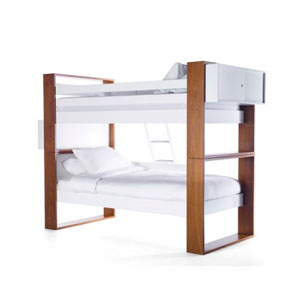
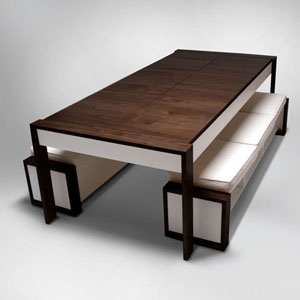
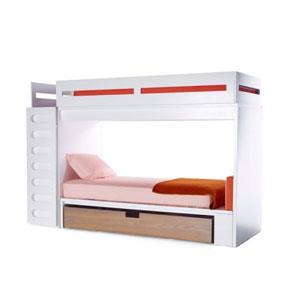
WHAT DID YOU DESIGN?
I designed the GlowHouse structure, including HDPE roof, wood framing and concrete piers. I also designed the LED tact switch input board and the power/ground/capacitor boards and the overall modular electronics design.
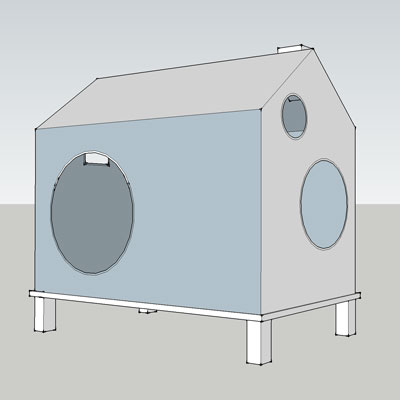
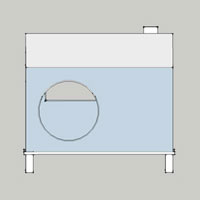
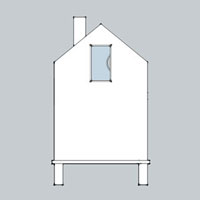
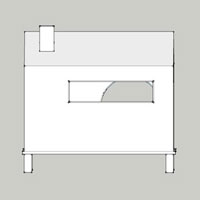
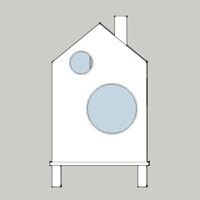
.jpg)
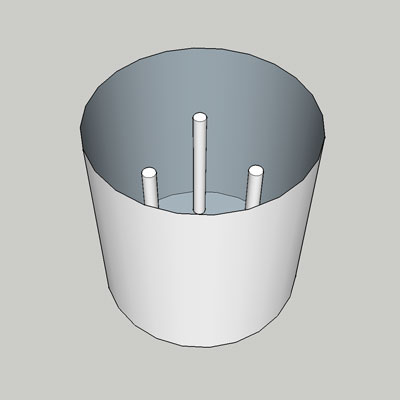
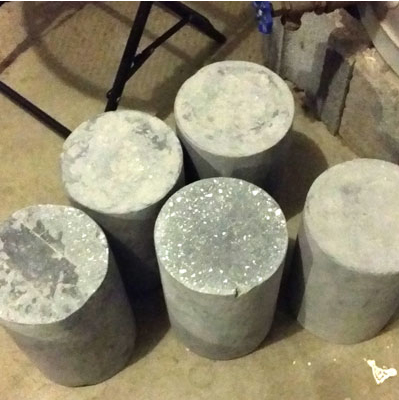
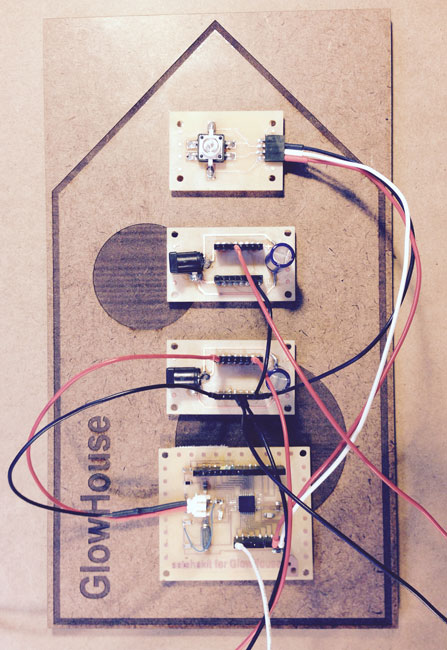
WHAT MATERIALS AND COMPONENTS WERE USED?
GlowHouse was made from an eco-friendly, formaldehyde-free walnut veneered plywood, HDPE plastic from King Plastic and concrete and rebar for the piers. A complete list of materials and components can be found here.
WHERE DID THEY COME FROM?
Whenever possible, materials were sourced locally in Providence, RI and Milan, NY (where I live). The electronics were sourced from the FabAcademy inventory, in addition to various online sources including AdaFruit, SparkFun, Amazon and Mouser Electronics. The sourcing of materials and components can be found here.
HOW MUCH DID THEY COST?
Definitely TOOOOOO much! But, I knew what I was getting into. Building something large can be expensive and prototypes are inherently experimental, which means lots of (costly) trial-and-error. The materials that I chose were also more on the premium end. I estimate spending $2500-$3000 building GlowHouse. The itemized costs can be found here.
WHAT PARTS AND SYSTEMS WERE MADE?
The house structure (walls, roof panels, floor and concrete piers) were made by me. Additionally the electronics, including button board, ATmega 328 board, power/ground/capacitor boards and LED wired matrix were all made by me. The WS2812 Flora NeoPixels, myriad fasteners, components and power supplies are store bought from various sources (see the GlowHouse inventory).
WHAT PROCESSES WERE USED?
(links include detailed documentation, videos, files, toolpaths, settings and screenshots, when applicable).
2d & 3d Computer Aided Design
Adobe Illustrator and Photoshop were used for the 2d design of the roof panels. VCarve was used to tweak 2d designs in preparation for CNC work. SketchUp was used primarily for the 3d modelling of the GlowHouse and the concrete and steel reinforced piers.
Electronics Design & Fabrication
I modified the Satshakit ATmega 328 board design by removing a reset button to accommodate a sturdier two-pin power connector. I designed, fabricated and tested an LED tact switch board and two power/ground/capacitor boards. I integrated the four boards into a modular electronics system.
Programming
I modified and combined the Arduino IDE Button and Neopixel Strand Test sketches to test the GlowHouse prototype.
I did a LOT of work on the CNC and fabricated the entire GlowHouse structure (wood and HDPE) on Big Blue, including the walnut structure, HDPE roof and accessory components. This work spanned several months and is documented in detail in the Computer Controlled Machining assignment.
I attempted to make a 9 button board initially, but was unsuccessful. Then after simplifying the scope of my final project, I made a one button LED tact switch board that interfaces with a Satshakit-derived ATmega 328 board successfully. This work is documented in detail for the Inputs assignment.
The roof is one big output device with an 8x12 network of WS2812 LEDs that are controlled by the electronics described previously. Making the roof panels into an output devices was another significant undertaking and is documented in detail for the Outputs assignment.
I used concrete and rebar for the first Composites assignment to make the supporting piers for the GlowHouse. This work is documented fully in the Composites assignment.
Project Management
I tried multiple project management tools, including Trello, Evernote and GQueues. With each one, I detailed the projects ahead and assigned timelines, due dates, contingencies, etc. My favorite? None of them! I am a list maker and it works much better for me because it's spontaneous, easy and satisfying to do a handwritten emptying of my brain. I love to cross things out! My "to do" list is in a notebook that is next to my work area and is instantly available. It doesn't get lost in a tab of my 8th overtabbed Chrome window. Still, the personal project management web-based apps are evolving and I like the idea of electronically storing and tracking projects. It is worth revisiting for my next big project!
I did use OmniGraffle throughout the evolution of my final project to visualize the physical project layout of the electronics, in particular. Here is the most recent of these diagrams:
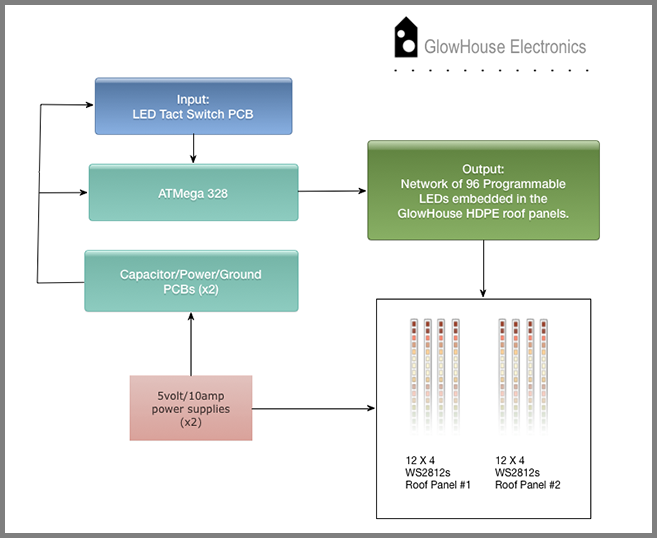
WHAT QUESTIONS WERE ANSWERED?
(these were the questions to be answered in the Applications & Implications assignment).
- Animation length and memory requirements?
Both were trivial in the prototype. Test sequence runs for a couple of minutes and requires only 2,776 bytes (8%) of program storage space, as reported when verified by the Arduino IDE.
- Difficulty integrating IR given schedule?
Will be implemented in a future spiral of development.
- Ridgeline joint? Fixturing of HDPE along ridgeline? Use spline joint, or will interior L-brackets hold together tightly enough?
Used piano hinge, which produced a nice joint that's flexible for disassembly of the GlowHouse and allows the panels to be opened like a book if access to the matrix is needed. I did not anticipate the distance between the panels that the piano hinge would create however. This oversight means the panels don't lie perfectly flat where they meet the wood peaks of the GlowHouse. This was another disappointment, although the roof is stable and with a screw, or two, I could make it flat.. but that would mean marring the top of the all-white roof panels, which I'd rather not do.
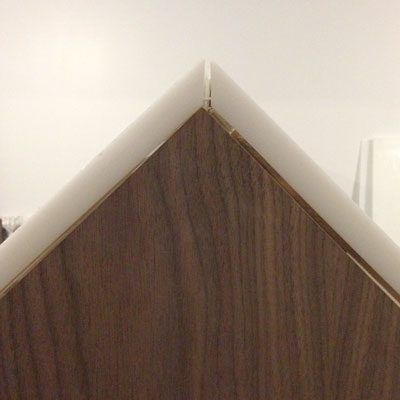
- Roof-to-wall joint? Dowels sufficiently strong? Can it still be disassembled?
I did not use dowels, so no issue here.
- Will insert fasteners become loose with humidity in summer? Do they need to be epoxied into holes?
This remains to be seen!! When I take it apart for veneer repair, sanding and finishing I will know better. Since wood expands in the summer, it's probably the best time of year to do this remaining work, since the insert fasteners will likely hold better than in the winter.
HOW WAS IT EVALUATED?
(these were the evaluation considerations I indicated in the Applications & Implications assignment).
- Does it work?
YES, it works!! Still, there's so much to do, but the prototype is working!
- Can it be expanded upon?
YES, the ATmega 328 has multiple pins available for future inputs and outputs and there are four cable outlets in the roof and four raceways in the interior corners for future cables, if necessary.
- It was designed to be assembled and disassembled - how well does it do that?
Could be better! GlowHouse takes 2 people to assemble and disassemble and 4 people to safely put the roof on and off of the structure. It remains to be seen how well the insert fasteners hold up with assembly/disassembly. The veneered edges adjacent to the screws are very fragile and chip easily. Finishing may help with splintering also. If I end up doing a second prototype, I will probably look for a veneered plywood substitute, even though I like the look of a lighter core and darker veneer.
- How can it be improved upon, expanded in functionality and fabricated for less cost?
The design can be improved upon after using the GlowHouse "as is" for a while and figuring out better what works and doesn't work. Some opportunities for improvement that are apparent to me now include designing with overhangs (surfaces that are completely flush require perfection in design, material and method), using batten filled fabric for the roof instead of HDPE to reduce cost and weight and using a kid tough(er) material instead of walnut veneer (although I do like the look of the latter!)
- How will it be evaluated?
The first evaluators were my kids! They've anxiously awaited completion of this project and are eager to try it out. Here is the official evaluation from the kids:
GlowHouseEvalutation from jill hartley on Vimeo.
- The next evaluators were my peers and instructors at FabAcademy. Here is the official evaluation from Neal:
GlowHousePresentation from jill hartley on Vimeo.
WHAT ARE THE IMPLICATIONS?
GlowHouse and FabAcademy have both been great learning experiences! Building GlowHouse using the tools and techniques I was learning weekly was a great way to put into practice all of the information. Of course, I wish I could have done more and it was difficult to scale back my goals (repeatedly), but I'm very happy to have a working prototype and I look forward to tackling the "upgrades" in the near future. It's my goal to continue developing and learning from this project (hopefully with my kids) and making it available on one of the open source furniture websites. My son would like the lights to respond to his rap music, so I think having the GlowHouse in our living room may also have some party entertainment potential(!) I look forward to designing with the new tools I've used and knowledge I've acquired!
THANK YOU!!!
Shawn Wallace for being a great teacher and for the wealth of knowledge, enthusiasm and patience you offered us in class every week.
Neil Gershenfeld for filling my brain with weekly lessons that were engaging, informative and ignited my curiosity about the possibilities!
Larry "the magician" Zagorsky for his kindness, dedication, friendship and abundance of patience working with me on Big Blue in the fabrication of my final project for many, many hours.
Kenzo Abiko for sharing his zen, friendship, supreme generosity in helping me with my 3d modelling, pcb design and other challenges, good humor and support!
Nadya Bedford for always being cheerful, a wealth of knowledge (and totally interesting random facts) and patient working with me on the electronics and programming of the GlowHouse.
Melita Morales, Jessica Metz, Lara Henderson, Simon Slowinski, Jenny Kostka, Matt Underwood, Kenzo Abiko and Jazz Walker (my classmates)... it feels like we've summitted Everest together. Can't imagine better pals to make the journey alongside! Good luck, lets stay in touch and congratulations!!!
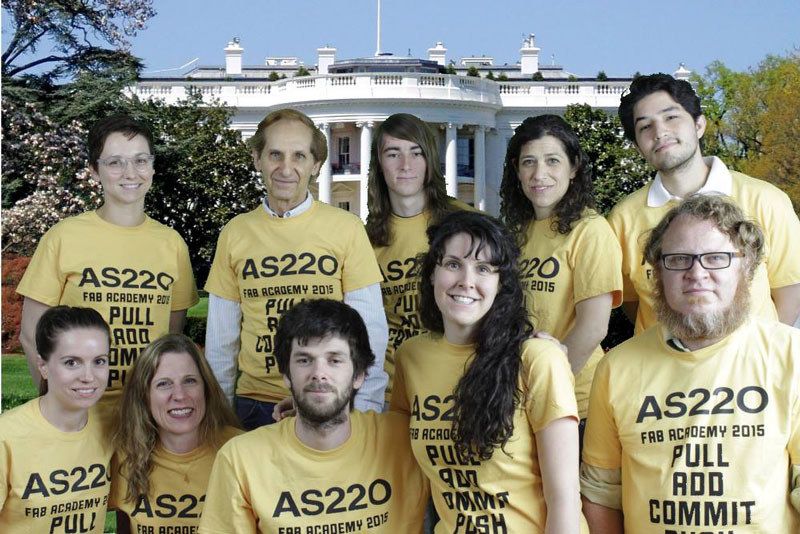
AS220 FabAcademy 2015 Class: Jenny, Larry, Jazz, Melita, Kenzo, Jessica, Jill (me), Simon, Lara, Shawn
Mark, Kaden and Aubree for the cheerleading and tolerance of my absence while living part-time in Providence for the past six months. For this, I am exceptionally grateful. FabAcademy would not have been possible without our loving and devoted sitters holding down the fort, Crystal and Beth. Love you all to the moon and back, always and forever!!

![]()
This work is licensed under a Creative Commons Attribution-NonCommercial-ShareAlike 4.0 International License.